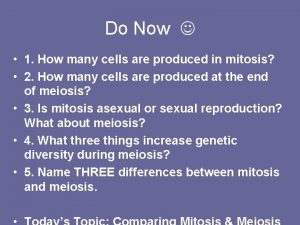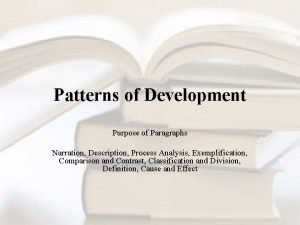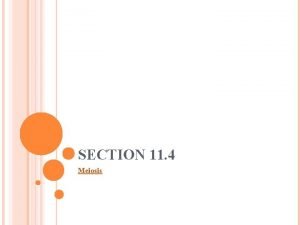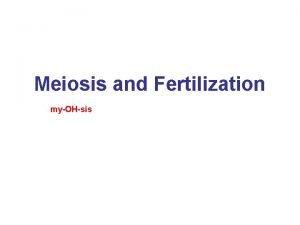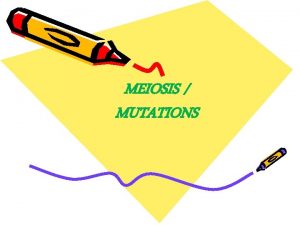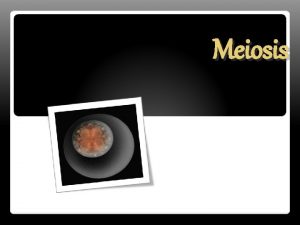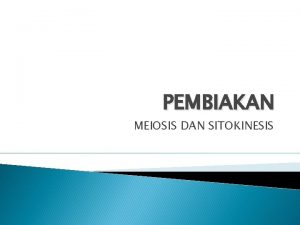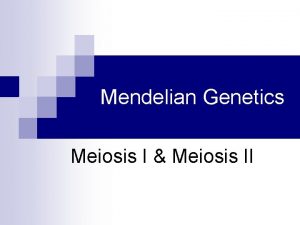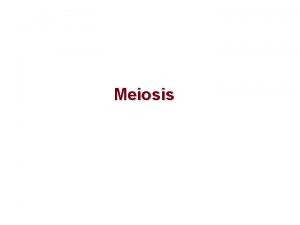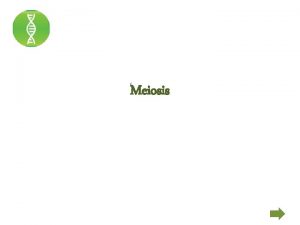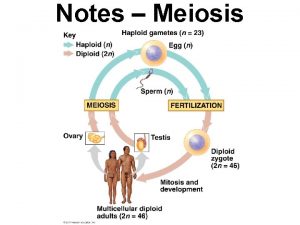Meiosis Details The steps Introduction Many steps of
















- Slides: 16

Meiosis Details The steps…

Introduction • Many steps of meiosis resemble steps in mitosis. • Both are preceded by the replication of chromosomes. • However, in meiosis, there are two consecutive cell divisions, meiosis I and meiosis II, that result in four daughter cells. • Each final daughter cell has only half as many chromosomes as the parent cell.

Overview • Meiosis reduces chromosome number by copying the chromosomes once, but dividing twice. • The first division, meiosis I, separates homologous chromosomes. • The second, meiosis II, separates sister chromatids.

Interphase • Before meiosis begins… • During interphase the chromosomes are replicated to form sister chromatids. – genetically identical and joined at the centromere. • the single centrosome is replicated. • Look familiar?

Prophase I • In prophase I, the chromosomes condense and homologous chromosomes pair up to form tetrads. • Crossing-over occurs… • At several sites the chromatids of homologous chromosomes are crossed (chiasmata) and segments of the chromosomes are traded. • A spindle forms from each centrosome and spindle fibers attached to kinetochores on the chromosomes begin to move the tetrads around.

Metaphase I • At metaphase I, the tetrads are all arranged at the metaphase plate. – Microtubules from one pole are attached to the kinetochore of one chromosome of each tetrad, while those from the other pole are attached to the other.

Anaphase I • In anaphase I, the homologous chromosomes separate and are pulled toward opposite poles.

Telophase I and Cytokinesis • In telophase I, movement of homologous chromosomes continues until there is a haploid set at each pole. – Each chromosome consists of linked sister chromatids. • Cytokinesis usually occurs simultaneously. • In some species, nuclei may reform, but there is no further replication of chromosomes

Prophase II • Meiosis II is very similar to mitosis. – During prophase II a spindle apparatus forms, attaches to kinetochores of each sister chromatid, and moves them around. • Spindle fibers from one pole attach to the kinetochore of one sister chromatid and those of the other pole to the other sister chromatid.

Metaphase II and Anaphase II • At metaphase II, the sister chromatids are arranged at the metaphase plate. – The kinetochores of sister chromatids face opposite poles. • At anaphase II, the centomeres of sister chromatids separate and the now separate sisters travel toward opposite poles.

Telophase II • In telophase II, separated sister chromatids arrive at opposite poles. – Nuclei form around the chromatids. • Cytokinesis separates the cytoplasm. • At the end of meiosis, there are four haploid daughter cells.

Male and Female Differences • Males: 4 sperm produced • Females: 1 ovum + 3 polar bodies (which die)

Mitosis and Meiosis Differences • Mitosis and meiosis have several key differences. – The chromosome number is reduced by half in meiosis, but not in mitosis. – Mitosis produces daughter cells that are genetically identical to the parent and to each other. – Meiosis produces cells that differ from the parent and each other.

• Mitosis produces two identical daughter cells, but meiosis produces 4 very different cells.


 Meiosis vs mitosis anaphase
Meiosis vs mitosis anaphase Chromosomes number is maintained mitosis or meiosis
Chromosomes number is maintained mitosis or meiosis Meiosis genetic variation
Meiosis genetic variation Chromosome disability
Chromosome disability Study guide chapter 10 section 1 meiosis
Study guide chapter 10 section 1 meiosis Meiosis introduction activity
Meiosis introduction activity Telophase 1
Telophase 1 Minor and major supporting details
Minor and major supporting details Signal words
Signal words How many cells are produced in meiosis? *
How many cells are produced in meiosis? * How many daughter cells are formed in meiosis? *
How many daughter cells are formed in meiosis? * Meiosis jeopardy
Meiosis jeopardy Narrative pattern of development examples
Narrative pattern of development examples Meiosis steps
Meiosis steps Hình ảnh bộ gõ cơ thể búng tay
Hình ảnh bộ gõ cơ thể búng tay Ng-html
Ng-html Bổ thể
Bổ thể









